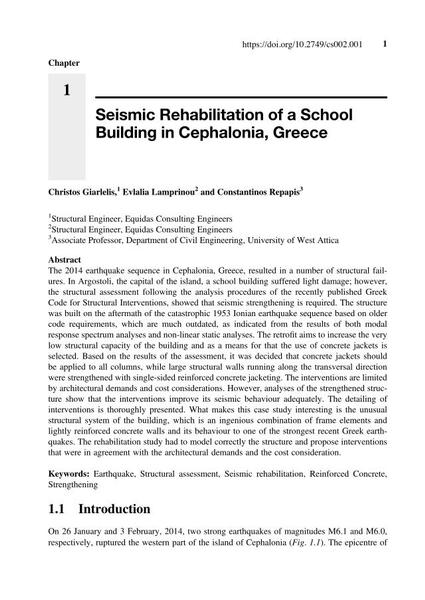Seismic Rehabilitation of a School Building in Cephalonia, Greece

|
|
|||||||||||
Bibliographic Details
| Author(s): |
Christos Giarlelis
(Structural Engineer, Equidas Consulting Engineers)
Evlalia Lamprinou (Structural Engineer, Equidas Consulting Engineers) Constantinos Repapis (Associate Professor, Department of Civil Engineering, University of West Attica) |
||||
|---|---|---|---|---|---|
| Medium: | book chapter | ||||
| Language(s): | English | ||||
| Published in: | Case Studies on Conservation and Seismic Strengthening/Retrofitting of Existing Structures | ||||
|
|||||
| Page(s): | 1-20 | ||||
| Total no. of pages: | 20 | ||||
| Year: | 2020 | ||||
| DOI: | 10.2749/cs002.001 | ||||
| Abstract: |
The 2014 earthquake sequence in Cephalonia, Greece, resulted in a number of structural failures. In Argostoli, the capital of the island, a school building suffered light damage; however, the structural assessment following the analysis procedures of the recently published Greek Code for Structural Interventions, showed that seismic strengthening is required. The structure was built on the aftermath of the catastrophic 1953 Ionian earthquake sequence based on older code requirements, which are much outdated, as indicated from the results of both modal response spectrum analyses and non-linear static analyses. The retrofit aims to increase the very low structural capacity of the building and as a means for that the use of concrete jackets is selected. Based on the results of the assessment, it was decided that concrete jackets should be applied to all columns, while large structural walls running along the transversal direction were strengthened with single-sided reinforced concrete jacketing. The interventions are limited by architectural demands and cost considerations. However, analyses of the strengthened structure show that the interventions improve its seismic behaviour adequately. The detailing of interventions is thoroughly presented. What makes this case study interesting is the unusual structural system of the building, which is an ingenious combination of frame elements and lightly reinforced concrete walls and its behaviour to one of the strongest recent Greek earthquakes. The rehabilitation study had to model correctly the structure and propose interventions that were in agreement with the architectural demands and the cost consideration. |
||||
| Keywords: |
structural assessment earthquake reinforced concrete strengthening seismic rehabilitation
|
||||
